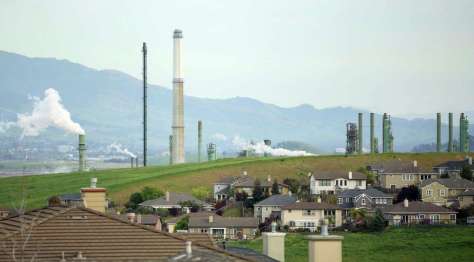[Note from BenIndy: Valero’s Benicia Refinery is the 5th largest stationary greenhouse gas (GHG) emitter in California. As Sunflower Alliance founding member Shoshana Wechsler notes below, “[t]he thing that continues to strike me is that the Bay Area has no clue how important we are as a major fossil fuel hub. […] We need to understand that refining both petroleum and biofuels has a very negative effect on our public health and obviously contributes mightily to the climate crisis.” Let’s enter 2024 with clear eyes…and hope for clearer lungs come 2025.]

SF Chronicle, by Kurtis Alexander, December 31, 2023
California’s largest greenhouse gas polluters, from power plants to oil refineries to chemical manufacturers, produced slightly fewer emissions last year than the previous year, federal data shows. But it’s still too much planet-warming gas to cut significantly into the problem of climate change, environmentalists say.
Three of the five biggest carbon emitters in the state were in the Bay Area, according to the Environmental Protection Agency’s 2022 data on large polluting facilities. All three were refineries in the East Bay, where the process of turning crude oil into gasoline, jet fuel and other high-demand petroleum products creates substantial greenhouse gas discharges — even before the fuels themselves are used in vehicles or planes.
The refineries were among 367 large stationary sites in California that collectively reported 93 million metric tons of carbon pollution last year, a decline of about 1% over 2021, according to the data. The facilities produce about a quarter of the state’s total human-generated greenhouse gases, which does not include wildfires. Cars and trucks remain the biggest source of carbon emissions.
“The thing that continues to strike me is that the Bay Area has no clue how important we are as a major fossil fuel hub,” said Shoshana Wechsler, a founding member of the Sunflower Alliance, an East Bay group that advocates for reducing refinery pollution. “We need to understand that refining both petroleum and biofuels has a very negative effect on our public health and obviously contributes mightily to the climate crisis.”
Worldwide discharges of greenhouse gases, notably carbon dioxide, methane and nitrous oxide, have contributed to warming the atmosphere about 2 degrees Fahrenheit in the post-industrial age. The heat, scientists say, has led to a host of problems, from an increase in drought and wildfire to rising seas and more extreme weather. The Earth’s 10 warmest years on record all were logged since 2010. This year is on track to be the hottest yet.
California regulators have established some of the most ambitious policies to restrict the release of greenhouse gases from large polluting facilities, including a cap-and-trade program that forces emitters to buy permits to pollute and requirements that electric utilities generate increasing amounts of clean energy.
Over the past decade, carbon emissions from the state’s big polluters have declined nearly 20%, according to the EPA data.
Many, though, say industry is still given too much leeway and stricter regulation is necessary given the climate challenge at hand. The state has a broad goal of reaching zero carbon emissions, on net, by 2045.
“Major polluters continue to pollute somewhat unabated,” said Nihal Shrinath, an associate attorney for the Sierra Club based in Oakland. “We really need to see much more aggressive emission reductions over the next 25 years.”
Shrinath said much of the decline in pollution from large facilities was due, not to regulation, but to unrelated factors, like Californians being more efficient with their energy use and needing less fossil fuels.
California’s top five greenhouse gas emitters were all oil refineries, according to the EPA data. Two were in Southern California in addition to the three in the East Bay: Chevron Richmond Refinery, Valero Benicia Refinery and Martinez Refining Company.
Ross Allen, a spokesperson for Chevron, described the company’s Richmond refinery as “absolutely essential to modern life in the Bay Area,” saying the facility supplied 60% of the fuel for Bay Area airports and about 20% of the gasoline used in Northern California. It also provides more than 3,000 jobs.

“We are working to reduce carbon intensity of our operations, while continuing to provide an essential product,” he said.
The state’s refineries cumulatively emitted 22 million metric tons of carbon pollution in 2022, according to the EPA data. Refineries were the second-most-polluting type of facility, following power plants, which are far more numerous and emitted 35 million metric tons last year. The chemical industry, manufacturing hydrogen, nitrogen and other products, reported 10 million metric tons of emissions.
Also among California’s 25 biggest greenhouse gas polluters were two gas-fired power plants in Pittsburg and an oil refinery in Rodeo.
The EPA data on large polluting sites generally includes facilities discharging at least 25,000 metric tons of carbon dioxide and equivalent greenhouse gases a year, about what’s emitted by burning coal from 136 rail cars, according to the agency.
Since you’re here, learn more about Contra Costa’s search for accountability and transparency from refineries by clicking on any of the following links:
- Contra Costa Health Conducts Inspection at Martinez Refinery (CCH News | December 27, 2023)
- Contra Costa supes deliver letter outlining demands, ultimatum to Martinez refinery (MSN | December 28, 2023)
- ‘Unacceptable’: 21 hazardous materials releases, spills recorded at Martinez refinery (KRON4 | December 28, 2024)
- Turnover Rate Concerns Supervisors As Martinez Refinery Put On Notice (Patch | December 28, 2023)
- Contra Costa Health says PBF’s Martinez refinery incidents ‘unacceptable” (Reuters | December 28, 2023)
- List of demands follows surprise inspection of Martinez oil refinery plagued by problems (SF Chron | December 27, 2023)


You must be logged in to post a comment.